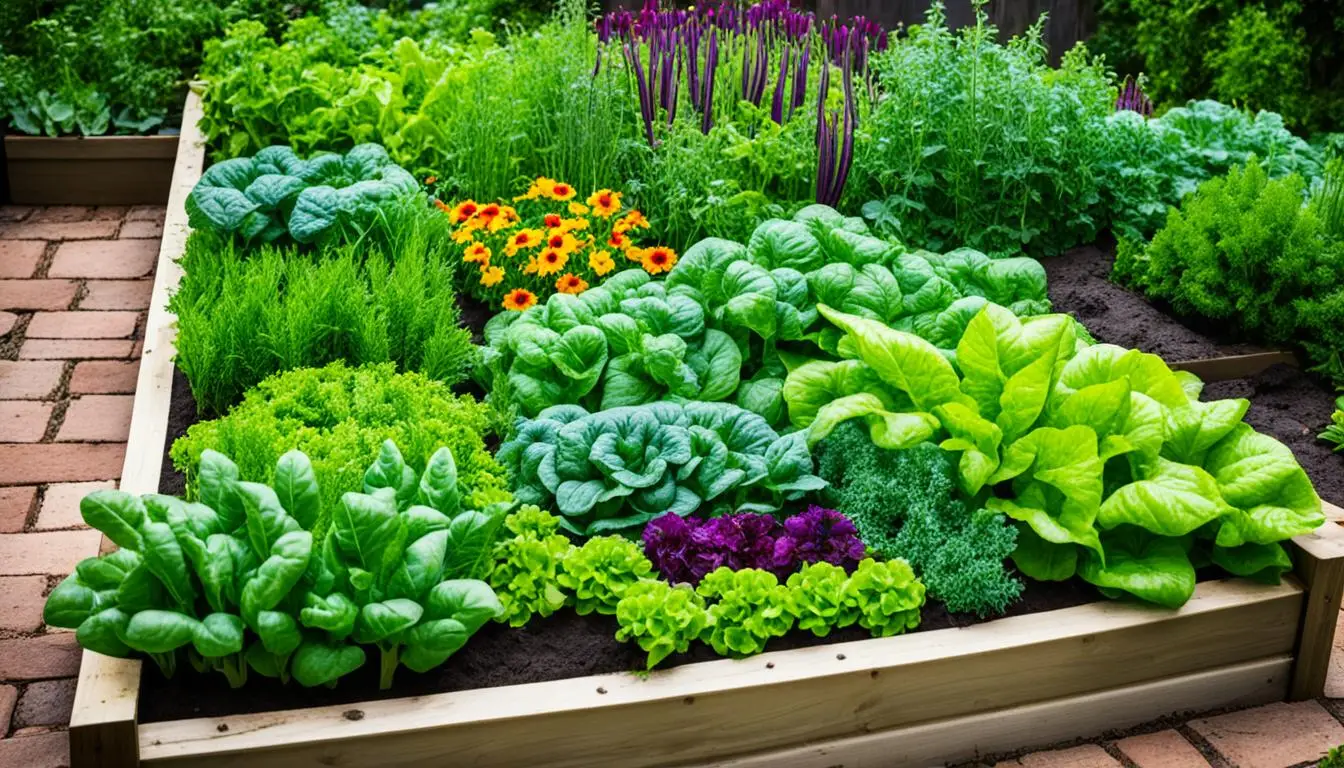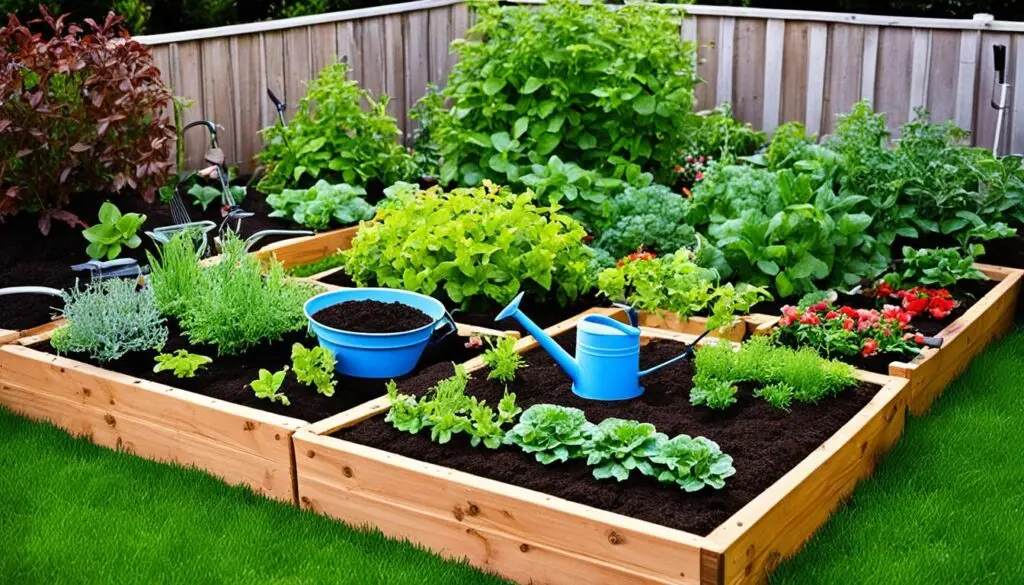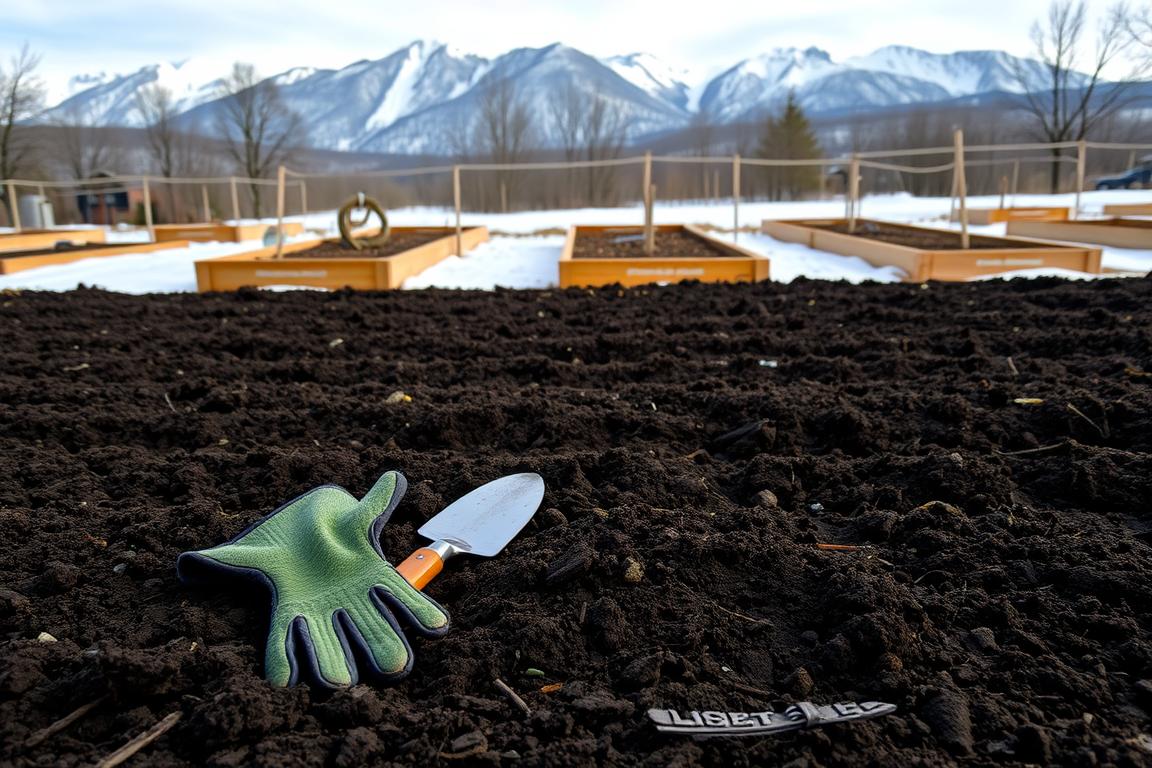If you have a small backyard, live in the city, or have a patio, raised bed gardening can change everything. This method involves making beds that are 6-8 inches high. These beds are great for small gardens, city farming, and making the most of limited space. They help you grow more food, make gardening easier, and keep pests away. Plus, they help you grow food in a way that’s good for the planet.
Key Takeaways
- Raised bed gardening is a highly efficient method for gardening in limited spaces.
- Elevated planting beds provide better soil quality, leading to healthier plant growth and higher yields.
- Compact and intensive gardening techniques maximize the use of small spaces.
- Raised beds make gardening more accessible, especially for those with mobility issues.
- Improved pest control and easier maintenance are additional benefits of raised bed gardening.
What is Raised Bed Gardening?
Raised bed gardening is a special way to garden that’s great for city folks, patio lovers, and those with little outdoor space. It’s all about making a special growing area that’s higher off the ground. This area is framed with wood, stone, or other strong materials.
Raised Bed Gardening is Above Ground
Raised beds stand out because they’re higher than the ground. This lets gardeners have better control over their garden. They can pick the height, from a few inches to over a yard tall, based on what they need.
Raised Bed Gardening is Small Scale
Raised beds are perfect for small gardens, fitting well in cities, on patios, and in small backyards. They help gardeners use their space well, making them great for vertical gardening, container gardening, and saving space.
Raised Bed Gardening is Intensive Gardening
Raised beds are great for growing lots of plants in a small area. They let gardeners pack more plants together, using a method called “square foot gardening.” This way, gardeners can get the most out of their space, making raised beds perfect for small-scale gardening lovers.
Starting With Better Soil
One big plus of raised bed gardening is the chance to start with top-notch, nutrient-packed soil. In traditional gardens, soil can get hard and lose nutrients over time. But with raised beds, you can pick the soil mix right from the start.
These beds are filled with a mix of garden soil, compost, and materials like vermiculite or perlite. These extras boost soil quality, soil composition, organic matter, and soil amendments. This mix gives plants a great start, helping them grow strong and produce more.
“Raised beds allow gardeners to start with a clean slate, building a nutrient-rich soil that’s tailored to the needs of their plants.”
By preparing the soil in raised beds, gardeners can make a space perfect for their plants. This focus on soil quality is key to a successful raised bed garden.
- Raised beds let you make your own soil mix
- Adding compost and perlite makes soil quality and soil composition better
- Soil rich in nutrients and well-aired means plants grow stronger
- Gardeners control the organic matter and soil amendments in raised beds
Harvests Can Be More Prolific
Raised bed gardening offers more than just the ease of elevated planting. Starting with top-notch soil and using intensive planting methods can lead to bigger harvests than traditional gardens. This approach often results in more food from the same space.
The design of raised beds lets you pack more plants into a small area. Techniques like square foot gardening help you make the most of your space. By planting specific numbers of plants in each square foot, you can boost your garden’s productivity.
Also, the better soil quality and drainage in raised beds help plants grow stronger and produce more. Many gardeners switch to raised beds and grow much more food in a small space. This method is perfect for urban and small-scale gardeners wanting to maximize their harvests.
“Raised bed gardening allows me to grow over 10 times more produce in the same amount of space compared to my old in-ground garden. The increased yields and space-efficient cultivation have been game-changing for my small backyard.”
Using raised bed gardening, with its focus on intensive gardening and space-efficient cultivation, gardeners can fully utilize their limited space. This leads to increased yields from their harvests.
Maintenance Is Easier
Raised bed gardening is a low-maintenance way to garden compared to traditional methods. The beds are elevated and contained. This design stops weeds and pests from getting in. It also makes gardening easier and ergonomic.
Preventing Weeds and Pests
The walls of raised beds keep weeds out and improve the soil quality. This makes it hard for weeds to grow. You can also use barriers like floating row covers or hardware cloth. These keep pests like slugs and snails away.
Easier on the Body
Raised beds are great for gardeners who have trouble moving around. They don’t need to bend or kneel as much. This makes gardening easier and more accessible for people with physical issues.
“Raised bed gardening provides a more accessible, low-maintenance gardening experience compared to traditional in-ground methods.”
Raised bed gardening has many benefits. It keeps weeds and pests away and makes gardening easier. It’s also ergonomic and accessible for everyone.
How To Start Your Own Raised Bed Garden
Starting your own raised bed garden is a great way to get into DIY gardening. It lets you create a beautiful outdoor space, even in small areas. You’ll need to think about the materials and the size of your garden bed when you begin.
Your Raised Bed Materials
Popular choices for raised beds include cedar, redwood, or pine wood. These woods are strong, easy to work with, and safe for your plants. Stay away from pressure-treated wood because it can harm your plants.
Other options are stone, cinderblock, or recycled materials like old barn wood or shipping pallets. Your choice should match your budget, style, and garden look you want.
Your Raised Bed Size
A common size for raised beds is 4 feet wide by 8 feet long. This size makes it easy to reach all parts of your garden. Raised beds can be any height, but 6-8 inches is a good range for roots and soil depth. Pick a size based on your garden space and gardening needs.
After picking your materials and size, it’s time to build your raised bed. Fill it with a mix of garden soil, compost, and other nutrients for the best plant growth. With your raised bed ready, you can start your DIY gardening and enjoy its many benefits.
Raised Beds Deter Pests
Raised bed gardening is great for keeping pests away. The beds are high off the ground, acting as a physical barrier against pests like slugs, snails, and rabbits. They also make it easy to add physical barriers like covers or mesh to stop birds and squirrels.
For pests like gophers, moles, or voles, putting hardware cloth at the bottom of the bed works well. Raised beds let gardeners use many pest-deterring strategies that are hard to use in regular gardens.
“Raised beds provide an excellent way to keep a variety of pests at bay, making them a popular choice for pest control in small-space gardens.”
Dealing with animal deterrents or pest infestations is easier with raised beds. Their design and the ability to add physical barriers make them a top choice for elevated gardening fans.
Using raised bed gardening, you can grow a pest-free garden. This means a better harvest and less worry.
“The Benefits of Raised Bed Gardening in Small Spaces”
Compact gardening, urban farming, and space-efficient agriculture are new ways to grow food in small areas. Raised bed gardening is a top choice for making the most of little space. By lifting the beds off the ground, gardeners get many benefits.
One big plus is better control over the soil. Gardeners can fill the beds with soil full of nutrients, perfect for plants. This leads to healthier plants and bigger harvests, even in tight spots like city gardens or small yards.
Raised beds are also great for people who have trouble moving around. They don’t need bending or kneeling, making gardening easier. Plus, you can pack more plants in a small space, perfect for compact gardening and urban farming fans.
Another big plus is the pest barrier these beds create. This cuts down on pest problems, making gardening more sustainable and space-efficient.
“Raised bed gardening is an efficient and sustainable way for urban and small-scale gardeners to cultivate their own fresh produce, even in the most space-constrained environments.”
Overall, raised bed gardening is a smart choice for those wanting to grow their own food in small spaces. It offers many benefits, letting gardeners enjoy fresh, healthy produce right in the city.
Selecting a Site for Your Raised Bed
Choosing the right spot for your raised bed garden is key. The spot you pick can greatly affect how well your plants grow and produce. Think about sun exposure and the microclimate of the area when picking a spot.
Sun Exposure Requirements
Most vegetables and popular garden plants love full sun. They need at least 6 hours of direct sunlight each day. Look for a spot that gets lots of sun exposure, away from shadows cast by buildings, trees, or other things.
If your area gets partial sun (4-6 hours a day), you can still grow many plants. But, you might get fewer crops than in full sun. Think about the garden location and how it affects sunlight throughout the day.
“Adequate sun exposure is essential for the optimal growth and productivity of your raised bed garden.”
Also, think about how close you are to water and how protected you are from strong winds. These things can also affect your raised bed garden’s health and success.
By picking the right site for your raised beds and making sure they get enough sun exposure, you can make a garden that flourishes. It will make the most of your garden location and use the microclimate to your advantage.
Preparing the Soil for Raised Beds
Starting a raised bed garden means laying a solid foundation. You need to prepare the soil before filling it with plants. By mixing the right stuff, you create a soil mix that feeds your plants and helps them grow big and strong.
The best mix for raised beds combines garden soil, organic stuff, and materials like perlite or vermiculite. This mix makes soil preparation better, improves soil composition, and adds soil amendments. It supports strong roots and lots of organic matter.
- Begin with top-notch garden soil for a nutrient base for your plants.
- Add an equal amount of compost or other organic stuff, like aged manure or leaf litter. This adds vital organic matter to the soil.
- Use perlite or vermiculite to improve drainage and air in the soil. This stops the soil from getting too dense and lets roots breathe and get moisture.
If you can’t find good garden soil, use more compost or organic stuff to make a great soil mix. It’s smart to test your soil and add soil amendments like fertilizers or lime if needed. This makes sure your plants get all the nutrients they need to grow well.
“Properly preparing the soil is the foundation for a successful raised bed garden. By taking the time to create a nutrient-rich, well-draining growing medium, you’re setting your plants up for optimal growth and bountiful harvests.”
With a well-prepared soil mix in your raised beds, you’re ready to enjoy the perks of this gardening method. Next, we’ll look at how to plant and manage your raised bed garden.
Planting and Intensive Gardening Techniques
Raised bed gardening is perfect for using space well. Square foot gardening is a great way to do this. It divides the bed into 1-foot squares. Each square has a certain number of plants, based on their size and how they grow.
This method lets you grow more plants in a small area than traditional row planting. It makes the most of your garden space.
You can also use vertical elements like trellises for plants that climb, like tomatoes and beans. This saves space and helps with air flow and disease prevention. Plus, you can easily get to all parts of the bed for succession planting.
This means you can grow early and late crops in the same space. This way, you get more harvests from the same spot all season.
Using intensive planting, square foot gardening, vertical gardening, and succession planting with raised bed soil can lead to big harvests from small gardens. These methods help you get the most out of your garden space. You’ll enjoy a lot of fresh, homegrown food.
“The beauty of raised bed gardening is that it allows you to pack a lot of productivity into a small space. With the right techniques, you can harvest an abundance of fresh, healthy vegetables and herbs from even the smallest of plots.”
Conclusion
Raised bed gardening is a great way to grow food in small spaces like backyards, patios, and city areas. It lets gardeners control the soil quality, leading to healthier plants and more food. The beds are above ground, making gardening easier and helping to fight weeds and pests.
It’s perfect for both new and experienced gardeners who want to grow their own food. Raised bed gardening lets you create a space for fresh fruits and vegetables in tight spots. By using small-space gardening, urban farming, and space-efficient cultivation, you support sustainable agriculture.
Raised bed gardening can turn even the smallest areas into gardens full of food. So, why not start your own raised bed garden today? You’ll get fresh, healthy food and the joy of growing your own food.
FAQ
What is raised bed gardening?
Raised bed gardening lifts the soil off the ground. It uses frames made of wood, stone, or other materials. This method creates a special growing area that’s different from traditional gardens.
What are the benefits of raised bed gardening?
Raised bed gardening in small spaces has many advantages. It improves soil quality, boosts harvests, makes maintenance easier, and helps control pests. By lifting the beds, gardeners can manage the soil better. This leads to healthier plants and more food.
How do I start a raised bed garden?
To begin, pick materials for the bed frame like wood, stone, or recycled items. The bed should be about 4 feet by 8 feet if you have space. Fill it with a mix of garden soil, compost, and other additives for the best results.
How do raised beds help with pest control?
Raised beds act as a barrier against pests like slugs, snails, and rabbits. They also make it easy to use barriers like row covers or wire mesh. These keep birds and squirrels away from your plants.
How do I prepare the soil for a raised bed garden?
Prepare the soil by mixing garden soil, compost, and additives like perlite or vermiculite. This blend improves drainage and nutrient levels. Aim for a mix of equal parts garden soil, organic matter, and porous materials.
What intensive gardening techniques can be used in raised beds?
Raised beds are great for intensive gardening. Try square foot gardening by dividing the bed into 1-foot squares. Plant different types of plants in each square based on their needs. Adding vertical elements like trellises can also help grow more plants in less space.








